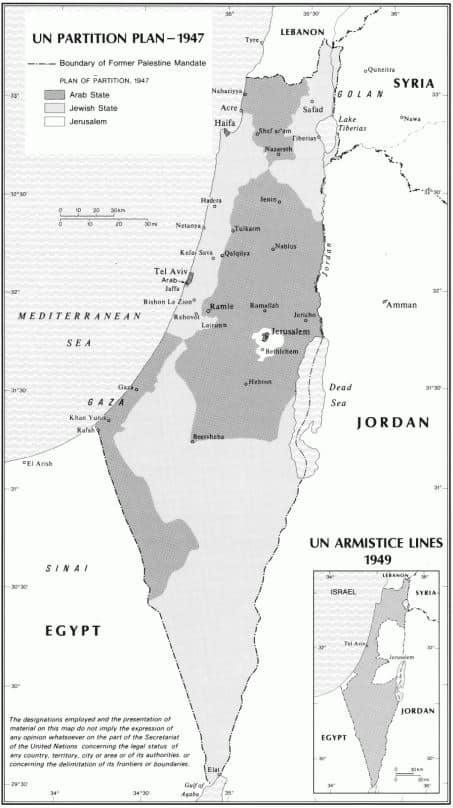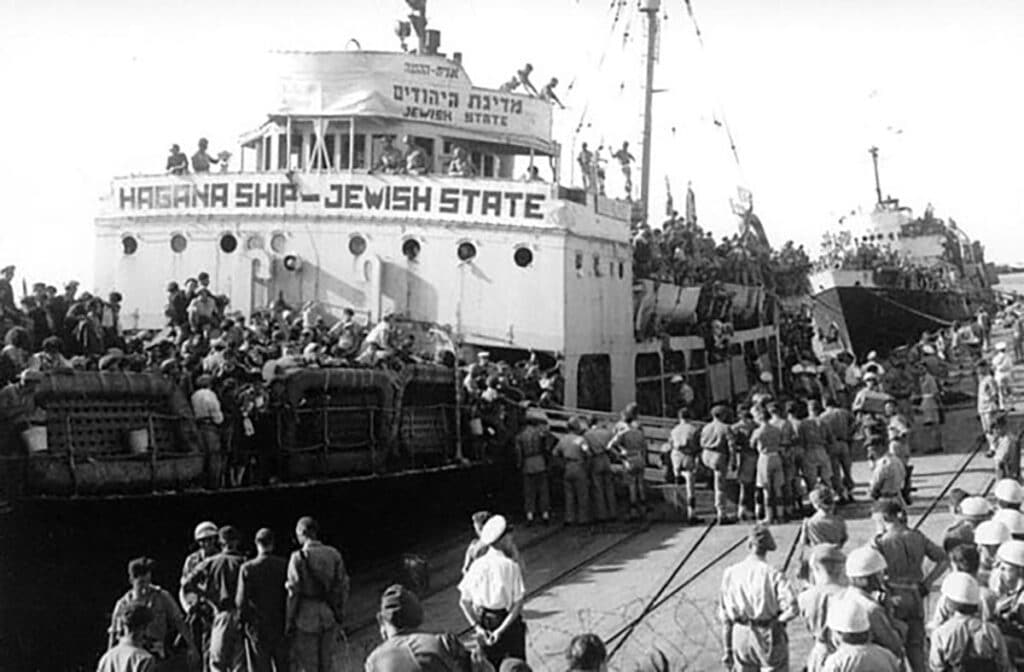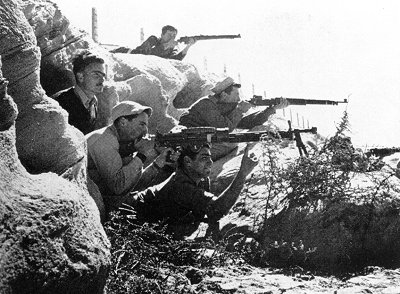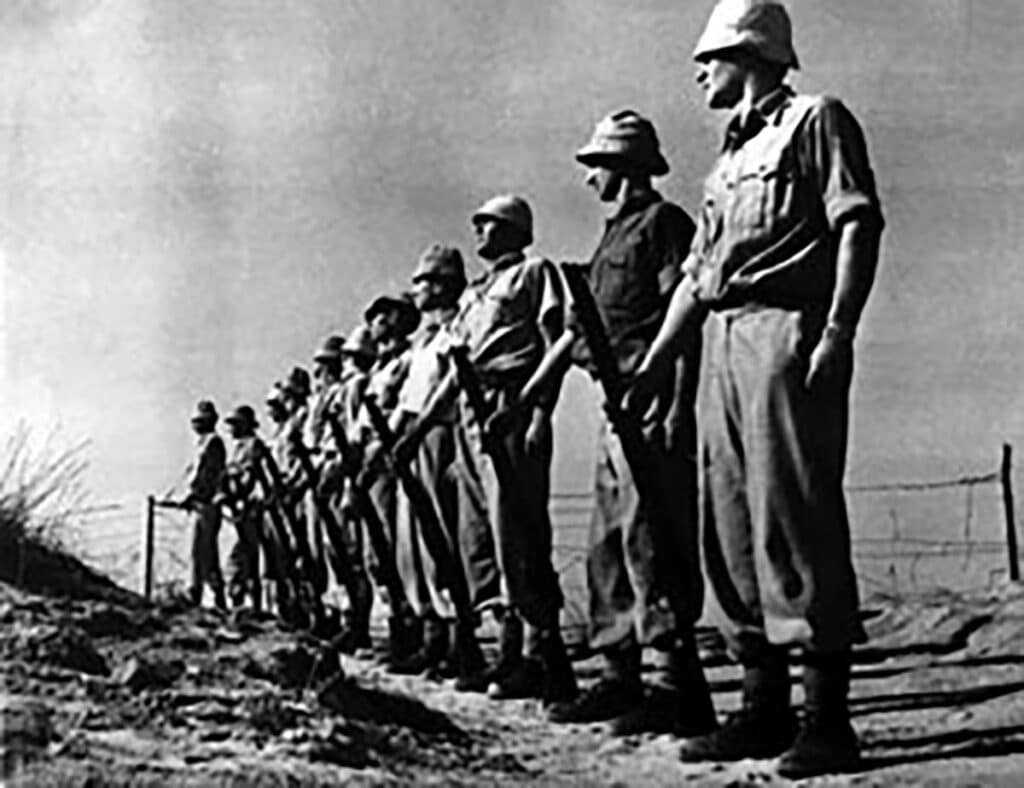For decades, Zionist activists had been working toward a country of their own. Their dream came true when the U.N. voted to partition Palestine into two states — one for Jews and one for Arabs.
Although the compromise wasn’t ideal, the Jews of Palestine were overjoyed. Unfortunately, they had only one day to celebrate before the war began.

Palestine’s Arabs strongly opposed the partition plan. They made up almost 70% of the population. Why should they split the land where they’d lived for centuries simply because the international community said so?
Arabs and Jews alike were still subject to British rule. In a futile attempt to keep the peace, the British outlawed militias and weapons and Jewish immigration. If anyone dared to violate their rules by fighting, building an armory or helping refugees sneak in, they would be sent to jail, deported, or even executed.
The Jews had no intention of giving up, so they ignored the British and operated three militias. They built meager armories and snuck in immigrants by the boatload. They also defended themselves against an Arab population twice their size, who had the support of the entire Arab world.

All this was happening right after the Holocaust when a third of the world’s Jews were murdered as the world watched. A quarter-million Jewish survivors and refugees languished in displaced persons camps across Europe, banned from immigrating to the only place that wanted them.
Zionism didn’t start with the Holocaust, but the annihilation of one in three Jews drove home its central point — no one is coming to save you. If you want to live, you have to fight for your life.
The 3 pre-IDF Jewish militias
The three Jewish militias were often bitterly divided, but they knew that if they didn’t work together, they didn’t stand a chance.
The biggest and best-trained militia, the Haganah, had weapons for less than a quarter of their force. Most of these were clunky old rifles secreted in illegal caches all over Palestine’s Jewish communities, with ammunition for less than three days of fighting.

They also had no heavy weaponry, like planes, tanks or anti-aircraft guns. For an organization whose name translates to “Defense,” the Haganah was very unprepared for the actual work of defending the Jewish state.
They needed help, so they sent a representative to America. He didn’t look like a fighter — he was only 5-foot-3 with flyaway hair, a heavy European accent, and pants belted sensibly above the waist. His name was David Ben-Gurion. Soon, he’d be the prime minister of the Jewish state, but he didn’t go to America as a head of state.
He went as a Jew, appealing to his brothers. Specifically, 19 brothers with the clout or the connections or the wealth to help and who were committed to the Zionist cause.
Harry Levine: The American Zionist activist
Harry Levine — the American millionaire owner of a plastics factory and U.S. Navy veteran — hadn’t grown up a Zionist.
In 1936, he attended a speech that changed everything. He recounted later: “We, the Jews in America were second-class citizens because we are the only people in the world that didn’t have a homeland…I was a second-class citizen, with my record, born in this country, enlisted in the Navy… a second-class citizen! Gee. This I didn’t like.”
He threw himself into Zionist activism. He didn’t need Ben-Gurion to tell him how dire the situation was for the Jews in Palestine, but the future prime minister didn’t mince words.
Ben-Gurion told him, “If you don’t act, we’re finished. Are you willing to do what it takes? Or will you let more than 600,000 Jews be overrun and exterminated?”
The 19 men in the room — Levine included — were willing to do what it took, even if it meant defying the U.S. government.
Challenges after the U.N. partition plan vote
The U.S. had voted in favor of the U.N. partition plan, but the vote had led to chaos. Jews, Arabs, and Brits were killing each other. The Arab world was rattling its sabers, making threats that bordered on genocidal. The U.S. gained nothing by ticking off its British ally or the entire Arab world — especially not when the Soviet Union was doing its best to worm its way into the Middle East.
The U.S. president was highly sympathetic to the Zionist cause, but State Department officials argued that this was politics. There was no room for sentimentality when the entire Middle East was at stake.
They issued an arms embargo, and sending weapons to anyone in Palestine was now a federal offense. Although Jewish leaders lobbied passionately at both the White House and the U.N., the State Department held firm. This meant that any American who sent weapons to Palestine would be investigated by the FBI.
Finding creative solutions
Almost immediately, Harry Levine threw himself into finding someone who could design a machine gun for Palestine’s Jews. It would have to be relatively lightweight, easy to put together and take apart, and — most importantly — it had to be shipped in pieces and assembled somewhere else.
Levine found the perfect designer. He told him that he was commissioning the gun as a “research project.” The designer needed plausible deniability if the FBI came knocking.
The Haganah’s arms specialist, who was working closely with the designer, knew they couldn’t keep the secret for long. So he told the designer the truth. The designer — a Swedish immigrant with absolutely no connection to the Jewish people — agreed to take the risk.
However, the Egyptians were also looking for a lightweight machine gun that could be easily assembled overseas, and they were offering six times as much money as the Jews.
The Haganah’s arms specialist told the designer to take the job, but the Swedish designer refused.
As the Swedish designer was drawing up blueprints, young American Jews were working overtime scouring government depots for surplus weapons-making machinery. After World War II, the U.S. was glutted with the tools to make weapons, and it was selling off these machines for pennies on the dollar.
However, it was illegal for a U.S. citizen to ship this kind of machinery to another country without permission from the State Department, and they were not going to give permission to send weapons-making machinery to a region under an arms embargo.
On the other side of the world, Haganah fighters unloading this machinery risked arrest — or worse — if the British caught them.
The Haganah, working together with American Jews, devised a plan. They’d take apart every single piece of machinery, label it, and stick each part in a different crate. Once the equipment arrived in Palestine, Haganah fighters would put it all back together using a makeshift manual that explained which of the 70,000 different parts went together.

It may have been the most organized joint effort the Jewish people had ever made. Haganah men traveled overseas to ask for help. Businessmen like Levine would call in connections and set up the warehouses and offices where the important work would get done.
College grads would pore over industry magazines to find deals on weapons machinery, and then drive around the country to buy it. Once the parts were disassembled, they were packed into crates by kids from Zionist youth groups, eager to do their part to help the Jewish state.
Uniting for the State of Israel
Ultimately, the underground militia did get enough weapons to fight off local Arabs — as well as the five surrounding nations that invaded the day after Ben-Gurion declared independence. In fact, that same underground militia became the core of the IDF. Overnight, the Jews of Palestine became Israelis.
If the Jewish people hadn’t come together, the State of Israel may not be standing here today.
